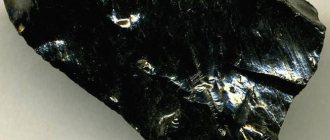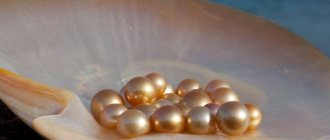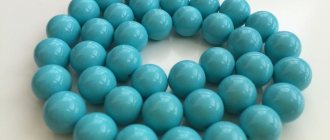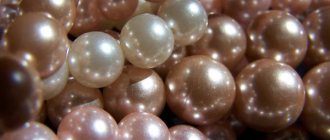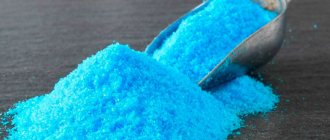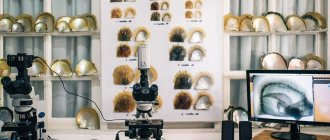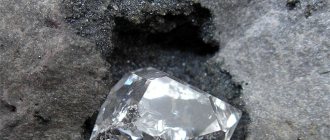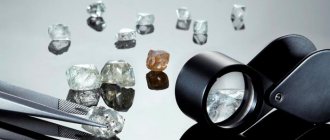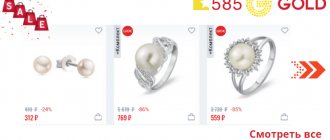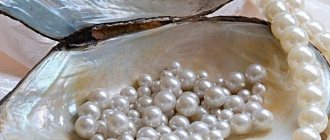Colt cutter and deshedder for cats and dogs. Right Way brush for long-haired animals
795 ₽ More details
Device for combing cats and dogs Discounted item (No. 65)
665 ₽ More details
Pullers for dogs
A string of pearls is the cherished dream of many representatives of the fair half of humanity, especially when it comes to natural mother of pearl, which is created by a mollusk. Meanwhile, few people know exactly what living organisms on earth produce this amazing biogenic formation and how the pearl oyster’s body works.
Few people know that it is mollusks that produce pearls
Species Margaritifera margaritifera
In appearance, a completely inconspicuous bivalve shell of black, brown and greenish tones with a glochidia larva hiding in it is the very creator thanks to whom humanity has the opportunity to admire the delicate beauty of river pearls. The common pearl mussel, which is also called European because of its habitat, is a fairly large mollusk, the size of which often exceeds 12 centimeters in length (the record figure was as much as 16 centimeters) and about 5 centimeters in width.
The range of the mollusk
Today, the pearl mussel mollusk is found mainly in the northern regions of the globe, spreading in small fresh water bodies of the Russian Federation (Valdai, Karelia, rivers flowing into the northern seas), the countries of the Scandinavian Peninsula, Belarus, on the Atlantic coast of France, as well as in the eastern and northern -eastern parts of Canada and the States. Unlike many other mollusks, the pearl shell prefers clean, non-stagnant rivers and streams with fast currents, which has a direct effect on the thickness of its valves, making them lighter and thinner.
At the same time, they manage to lead an almost motionless lifestyle, trying to dive into the bottom part of reservoirs where there is a minimum amount of silt and a lot of clean river sand with a rather heterogeneous substrate of pebbles of different sizes. Of great importance for this variety of mollusks is a high percentage of oxygen and a minimal content of salt minerals, which also thin the shell.
And if now such shells are very rare, then even in the last century one could easily find their numerous populations, representatives of which preferred to plunge their sharp ends into the sandy bottom at a depth of 25 centimeters to 2.5 meters or stick to cobblestones located directly on the river rapids. For example, in the reservoirs of the Kola Peninsula, researchers counted 70 shells per 1 square meter, but now only memories remain of such a density.
Now pearl shells are very rare in nature
Structure of a river shell
Having figured out where margaritifera margaritifera currently lives, it won’t hurt to get acquainted with its structure, which has a number of unique features of its kind. Among them it is worth highlighting:
- Both valves in the articulation zone have characteristic teeth, which, when closed, form a fairly reliable lock that prevents foreign objects from entering the shell. It is noteworthy that these teeth have completely different shapes, and while on the right valve they resemble an irregular pyramid, on the left side of the shell there are only two underdeveloped teeth, separated from each other by a small depression.
- The edge of the abdominal region of these mollusks has a flat and sometimes slightly concave shape, which, in principle, is not much different from the classic structure of bivalve shells. The same can be said about the excretory, reproductive and digestive systems of margaritifera margaritifera.
The color of bivalve shells directly depends on their age. The older the mollusk, the darker its shade will be. - The gills of a freshwater pearl mussel are located near its leg, and if the mollusk is in a calm state, then the water through which, in fact, its respiration occurs, enters the mantle cavity through the input siphon located in the lower part of the valve. After the liquid passes through the gills, it returns back, with the only difference that its removal from the body of the shell is carried out through a completely different siphon, called the upper one. That is why mollusks prefer to burrow into the river bottom with a sharp end, leaving both siphons and half-open valves at the top.
- The color of bivalve shells directly depends on their age. The older the mollusk, the darker its shade will be. A similar picture is observed in its pearlescent layer of cream and pale pink shades, which over time can become covered with characteristic greenish spots.
https://youtube.com/watch?v=S9zj76fCPe8
It should be noted that pearl mussels have the thickest valves, which are forced to live in hard water with a large amount of impurities (does not apply to reservoirs with a high concentration of salts, which tend to thin out the shells). At the same time, too soft water also does not benefit this organism, thinning its protective layer and leading to the formation of deep erosions in its upper part.
If the pearl river shell constantly lives in reservoirs with low salt concentrations, then over time, numerous protein layers called Tullberg layers are formed in its thick pearlescent layer.
Scientists note that as they age, the relief of the valves inevitably collapses, and observing these bizarre patterns is more or less possible only when studying the youngest representatives of this species.
Trades
But the fashion for pearls does not go away, and one hundred and fifty years is a considerable period, and therefore divers from pearl fisheries work tirelessly. Pinctads, and other pearl-bearing mollusks, rarely live alone. They usually form fairly dense settlements - pearl banks. They do not like fresh water, and therefore settle far from river mouths. The main fisheries for sea pearls are located on the island of Sri Lanka in the Gulf of Manara, in the Red Sea, the Sulu Sea (between the Philippines and the island of Kalimantan), off the coast of Australia, Japan, in the Persian Gulf, along the coasts of Venezuela, Panama and Mexico and on Margarita Island in Caribbean Sea. The pearls themselves differ in the location of the pearl jars: pearls found near the Australian coast are white; off the coast of Panama - golden. Pearls caught in areas between Japan and India have a strong luster and a pinkish tint. In these fisheries, pearl mussel fishing has been going on for several centuries, but it looks about the same as it did centuries ago: a pearl fisher, armed only with a knife, goes to the depths and stays there for about a minute, collecting shells in a special basket. No mechanics - just like in the time of Columbus.
Pearl oyster lifestyle
As is already known, the European pearl mussel leads an extremely passive lifestyle throughout its entire existence. It is noteworthy that this feature is observed not only in the processes of movement of the mollusk, which are almost completely absent, but also in its nutrition and reproduction. That is, to satisfy its natural needs, this living organism does not have to make practically any effort.
Nutrition and reproduction
The pearl mussel feeds on all kinds of microalgae and organic detritus, which are filtered by its own gills during respiration. This feature has led researchers to the opinion that the respiratory and digestive systems of the bivalve mollusk, based on very careful filtration, are inextricably linked and, in fact, are one whole. It is noteworthy that in just one day, a miniature shell manages to pass up to fifty liters of water through its gills, receiving with it not only oxygen, but also complete nutrition.
The pearl mussel feeds on all kinds of microalgae and organic detritus
Males do not have to work particularly hard in terms of reproduction, since all that is required of them is simply to throw out their seed, which tends to spread quite quickly throughout the entire reservoir, fertilizing the females.
Usually this process occurs in mid-August, because it is then that lazy mollusks, without moving a single step from their homes, release millions of their sperm, which fertilize the eggs of females through their half-open valves.
The formation of larvae occurs very quickly. By the end of August, there are about three million of these babies on the valve alone. Their further path is determined by instinct, because the female literally throws off a new generation, whose main task is to attach to other inhabitants of the reservoir as quickly as possible. Typically, the final phase of the formation of mollusks takes from 8 to 11 months ; outside the confines of another living organism, their development becomes impossible by definition.
Interesting Facts
Despite such a primitive structure, margaritifera margaritifera boasts a huge number of unique facts from its own life that amaze the imagination of the common man. And the most interesting of them are the following:
- The glochidium larva, which, in fact, is that extraordinary pearl shell, is in fact an ordinary river parasite that feeds on the waste products of carp and other representatives of this family. However, such a parasitic stage of development only benefits the carriers, because it is the glochidia that save the fish from premature death, significantly inhibiting the process of their aging after the end of spawning.
- The process of pearl formation in the tissues of a mollusk can be compared to a speck getting into the eye. And all because it begins with the entry of a small speck of dust into the bowels of the mollusk, which tends to irritate its soft tissues, causing them to secrete that same mother-of-pearl, which envelops the small debris layer by layer. Of course, one cannot expect a quick result, because in the course of research it was found that a pearl reaches its average diameter of 8 millimeters only after 35-40 years. However, it is worth the long wait as freshwater pearls are beautiful.
The formation of a pearl begins with the entry of a small speck of dust into the bowels of the mollusk. - For a long time, catching river pearls was considered an extremely profitable trade, because it was customary to embroider clothes of wondrous beauty with jewelry back in the 10th century. However, over time, the number of freshwater pearl mussels began to decline rapidly, as a result of which their production had to be curtailed. It is noteworthy that the first to show concern for the endangered mollusk was the Russian Emperor Peter I, who ordered a ban on their catching. Today, this species is threatened with complete extinction, which is why it was included in the Red Book and many other lists of a similar plan.
But the main feature of this freshwater mollusk is its longevity, because the age of some specimens reaches 250 years, which automatically allows the river pearl mussel to be awarded the honorary title of the oldest invertebrate animal.
By taking measures to reduce the catching and breeding of these mollusks, it is possible to preserve and increase the population, thereby providing humanity with the opportunity to continue to admire the exquisite beauty of river pearls.
The appearance of pearls
It’s probably worth talking about how the pearl itself actually appears. The Russian word “pearl” most likely comes from the distorted Chinese “gonchu” - it was from there, from Asia, that the first sea pearls could have come to Rus'. The ancients believed that pearls arise from the fertilization of the pearl oyster mollusk by a drop of ocean water. This statement was not questioned until the 15th century, when another assumption appeared - that the pearls were the eggs of bivalve mollusks. Only at the beginning of the 20th century, through numerous experiments, scientists came to the conclusion that the formation of pearls is just a protective reaction of the mollusk body. Despite the presence of filters, which have already been discussed, sometimes a foreign body gets between the shells - a grain of sand, a fragment of a shell, eggs of a parasite, or, at worst, dead parts of the mollusk itself, which it was not able to bring out. Due to the impossibility of removing the foreign body, the mollusk begins to build protection around it - covering it with alternating layers of nacre and conchiolin - the substances from which the mollusk shell itself is built. In other words, a pearl consists of the same substance as a shell, only it has a different shape - round or pear-shaped. So the pearl, to the great regret of jewelry lovers, is of biological origin, and therefore is not eternal. Already fifty to sixty years after being removed from the shell, pearls begin to become covered with cracks, and after one hundred and fifty years, they actually cease to exist as jewelry. This is due to the fact that the organic substances between the layers of nacre dry out, the pearl becomes inconspicuous and completely loses its value.
Physical and chemical properties
Pearl is an organic mineral. This distinguishes it from gemstones that are mined from the earth. In fact, “tears of the sea” are a product of a mollusk’s protective reaction to an external irritant entering the shell.
Its physical and chemical properties:
- formula - CaCO3;
- hardness - 3-4 on the Mohs scale;
- shine - pearlescent;
- fracture - shell-like;
- transparency - opaque, translucent;
- color - white, silver, gold, cream, pink, brown, blue, green, gray, black;
- density - 2.60-2.78 g/cm³;
- refractive index - 1.52-1.66 (for black - 1.53-1.69);
Pearls come in a variety of colors: white, silver, gold, cream, pink, brown, blue, green, gray and even black. Experts counted more than a hundred shades. The color is influenced not only by the type of mollusk-producers, but also by location and age.
